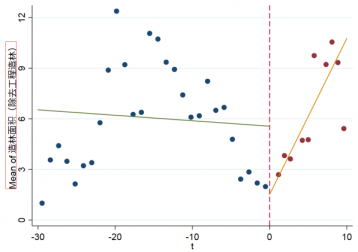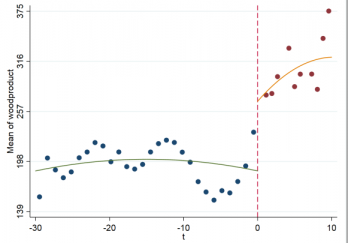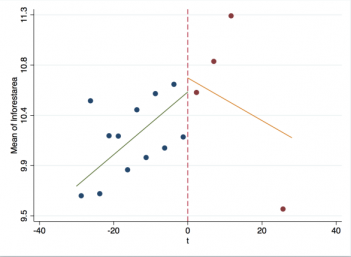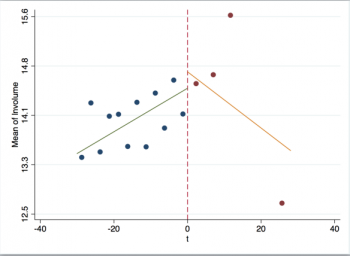论文总字数:20278字
目 录
摘要 3
Abstract 4
1、研究背景与意义 5
2、文献综述 6
2.1理论分析 6
2.2实证分析 7
2.2.1森林资源的测度相关文献 7
2.2.2产权下放与森林资源保护的相关实证结果 8
3、理论分析:产权激励与租值耗散 9
4、实证分析 10
4.1数据来源 10
4.2模型设定 11
4.3基本实证结果 12
4.4断点回归的有效性检验 14
5、结论 16
5.1总结 16
5.2改革建议 16
参考文献 18
致谢 19
产权安排与自然资源保护:来自中国集体林权改革制度的经验证据
陆蕴萍
, China
Abstract:
The issue of forest rights is the key to the development of forestry. Forest rights reform is the core of forestry reform. Scholars at home and abroad have discussed in detail on the relationship between property rights arrangements and the protection of forest resources. However, no unified views have been formed. Most scholars believe that the decentralization of state-owned property rights is conducive to the protection of natural resources, but some scholars insist that the decentralization of property rights will also make it impossible for forest resources to continue to protect. After undergoing the reform of the collective forest rights system, China's forest resources property rights have been decentralized and implemented in the hands of peasant households. This provides a natural laboratory for studying the nature of property rights and environmental protection of forest resources, and provides a possibility for accurately estimating the relationship between the two. Therefore, based on the quasi-natural experiment of China's collective forest rights system changes, this paper uses the national forest resources inventory data to estimate the protective effect of collective forest rights institutional changes on forest resources by adopting Sharp Regression Discontinuity. The empirical research results show that the implementation of the collective forest right system across the country does not have a significant protective effect on forest resources. It is mainly reflected in the fact that the reform of forest tenure system has no significant effect on afforestation area, forest area, and forest volume. This is mainly because of the implementation of China's key forestry projects and the implementation of family management, the reduction in the size of forest lands and the fact that forest lands are becoming more fragmented are not conducive to the management of forest farmers, which is not conducive to the expansion of forest resources. However, the impact on the wood product is very significant. This is mainly due to the main output of wood as a source of forest resources and the increasingly rise in demand for timber under the continuous development of the national economy. Based on this, it is considered that the reform of collective forest rights system is not ideal for the performance of forest resources protection.
Key words: Property Rights Arrangement; forest resources; Collective forest rights system; Sharp Regression Discontinuity
目前,自然资源是地球生态系统的重要基础,而林地资源在我国不仅是生态建设中的重要组成部分,也是我国基础经济产业之一。环境问题的日益严重更加要求我们重视林业的发展 ,因此将林业的经济效益和生态效益相结合将是我们要好好思考的问题。而林业政策直接关系着我国林业发展情况,其中产权政策是关键,因此本文将要探究产权安排与自然资源保护之间的关系。
1、研究背景与意义
改革开放以来,林权问题备受学术界关注。林权问题是林业发展的关键,林权改革是林业改革的核心。20世纪50年代以来,我国森林产权制度发生了数次变革。在土地改革时期,山林以个人所有为主。1957年开始,农村土地调整,从互助组发展到初级社再到高级社,将原合作社的山林全部归公社所有。这一时期的产权制度及其实现形式均以保障国家和集体利益为核心,产权交易性的缺失导致了森林资源保护的破坏。1981年开始实行林业“三定”政策,是以“稳定山权和林权、划定自留山、确定林业生产承包责任制”为主要内容,标志着我国森林资源权属多元化的开端,这项政策使大量村民分到自留山并且承包了责任山,林业经营权进行了由集体向村民手中的转换,出现了由集体所有但由村民经营的局面。1985年,集体林区开始实行“取消木材统购,开放木材市场,允许林农和集体的木材自由上市,实行议购议销”这种放开林木交易权的政策。然而,产权政策的不稳定造成林农之间的恶性竞争,促使林农盗伐森林,森林破环现象十分严重。20世纪90年代开始,林权主体呈现多元化时期。村集体开始将部分或全部森林控制权进行转移,主要通过股份合作制、荒山拍卖和林地租赁等方式,由此村民获得了林地使用权与所有权,出现了以家庭经营为主,大户经营、租赁经营、股份合作经营、拍卖经营等多种林权经营形式并存的格局。林业三定后,集体林经营制度的频繁变动使林农对林业政策严重缺乏信任感,同时林业三定又没有赋予林农以排他性的森林产权,因此必然导致森林资源的破坏。2003年,以“明晰所有权、放活经营权、落实处置权、确保收益权”为主要内容的政策,标志着林权改革进入全面改革时期,福建省通过股份合作制实行折股经营,实现了林业经营管理制度的创新。2008年,国务院颁布的《中共中央国务院关于全面推进集体林权制度改革的意见》标志新一轮的集体林权制度改革开始,改革主要内容为分山到户,不再提倡均股。这一时期从形式上确保了林农获得排他性产权的保障,产权的稳定性也得到了确立,再加上集体林权制度的激励功能,从而促进了森林资源的增长。因此,探究产权下放是否会促进森林资源的保护是至关重要的。
此外,林权制度改革是巩固和完善农村家庭承包经营制度的重大变革,对促进农民就业、推进现代化林业发展以及促进人与自然和谐相处具有重要的意义,并且以建设生态文明为根本任务,促进了经济社会的可持续发展。因此探讨集体林权制度改革具有重要的现实意义。
2、文献综述
2.1理论分析
国外学者对产权与资源保护之间的研究略多,而且研究发现他们更加侧重于产权形式与产权安全的研究。土地产权可以采取多种形式,但我们将土地产权安全定义为社会维护土地产权的保证。De Oliveira(2008年)表明,不安全的产权是土地冲突和森林砍伐的主要原因之一。因此,产权安全的影响已成为最近许多讨论的焦点,讨论土地产权安全十分必要。
发展经济学家通过至少三个不同的框架:博弈论,福斯特曼最优木材轮伐模型,最优投资模型,探讨土地产权安全对森林的影响,发现产权下放有利于森林资源的保护。
剩余内容已隐藏,请支付后下载全文,论文总字数:20278字
相关图片展示:





该课题毕业论文、开题报告、外文翻译、程序设计、图纸设计等资料可联系客服协助查找;


